 It wasn't too many years ago that fan-cooled sleds and then the liquid-cooled 500cc machines were the economy class of mountain snowmobiles.
It wasn't too many years ago that fan-cooled sleds and then the liquid-cooled 500cc machines were the economy class of mountain snowmobiles.
They were a relative bargain compared to other mountain sleds and they were fairly inexpensive to maintain. Those machines weren't intimidating and they seemed to have the right horsepower for those looking to get a foot in the door of this winter sport that hard core snowmobilers were raving about. All those features also made those sleds a favorite among snowmobile rental outfits.
For a myriad of reasons even we don't fully understand, the 500cc and fan cooled sled segment has melted into the past like a spring thaw. Those smaller sleds have gradually gotten bigger-engine size wise at least-and the 600cc mountain segment is the new economy class. Sort of. There are two models still around for 2010-the Polaris Trail RMK and Yamaha Phazer MTX-with smaller engine displacements than the 600s. So technically, you could consider those the economy and/or beginner class of sleds and rightfully so.
However, the snowmobile industry has warmed up to the idea and it's generally accepted these days that the 600 mountain segment is the economy/beginner class. Part of that is due to, we think, the horsepower levels offered by the 600s compared to the Trail RMK and Phazer. Generally speaking, the horsepower average in the 600 is about 120 compared to the Phazer MTX at 80 hp and the Trail RMK at about 60 hp.
This gradual acceptance as the beginner's class could also be due to the fact there just aren't many options left (only the Trail RMK and Phazer MTX as mentioned) when it comes to those who want to start small and work up from there.
As for the economy part of this beginner class equation, well, that is slower to take hold in people's minds-in and out of the sport. Is it possible to classify a class of snowmobiles as being the economy segment when the least expensive sled in this mountain segment is $8,099 and the average price of the sleds is $9,240?
Not many consider that "economy" unless you're a part of the snowmobile industry and you look at the prices in the 800 class where the average price is well above $10,000. This isn't just our take on the economy idea, as some of the major snowmobile manufacturers are marketing their mountain 600s as "economy" sleds.
 But once again, there aren't many choices when you're looking to break into the sport with a new snowmobile. You can pick up some nice used sleds for some decent prices but we're here to talk the 2010 class of 600s.
But once again, there aren't many choices when you're looking to break into the sport with a new snowmobile. You can pick up some nice used sleds for some decent prices but we're here to talk the 2010 class of 600s.
And while we'll touch on why the 600 class works well for those new to the sport or even for younger riders, we're staying with the economy theme as we explore this segment. We turned to Investopedia (www.investopedia.com) to find out the latest buzz words in the world of money to help us cover the 600 class. The words and phrases we chose are actual financial buzz words from Investopedia. We didn't make them up. We'll admit we cherry picked some of the descriptions (actual descriptions are inside "quote marks") from those buzz words and worked them to our advantage (we call it editorial license) but the original phrases are right from Investopedia.
Economic Indicators
 One of the economic indicators watched closely in today's economic climate is industrial production. When it comes to the industrial production of the mountain 600 class, there are six different models available-one from Arctic Cat, two from Polaris and three from Ski-Doo, although by the time you read this, there are really one two sleds you can buy from Ski-Doo as the other is a spring-only model.
One of the economic indicators watched closely in today's economic climate is industrial production. When it comes to the industrial production of the mountain 600 class, there are six different models available-one from Arctic Cat, two from Polaris and three from Ski-Doo, although by the time you read this, there are really one two sleds you can buy from Ski-Doo as the other is a spring-only model.
From Arctic Cat there is the M6, which comes with a 153-inch track. Polaris offers the 600 RMK with a 144- or 155-inch track. And Ski-Doo's offering is the Summit Sport (146-inch track) and Summit Everest (146-inch track).
After The Bell
If you failed to lay your moola down earlier this spring on a Ski-Doo Summit X 600, then you missed out unless you have some serious connections inside Ski-Doo.
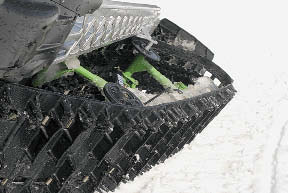 And that's too bad because the Summit X 600 is probably the head of the 600 class, thanks to an impressive suspension package and the fact that it's the second lightest sled in this class, behind the Summit Sport. The Summit X comes with HPG Plus shocks in all four positions, which just add to this model's already great ride in the bumps. And its dry weight of 446 lbs. is double digits lighter than its competition. The X also comes with Ski-Doo's premium gauge package and race-style brake.
And that's too bad because the Summit X 600 is probably the head of the 600 class, thanks to an impressive suspension package and the fact that it's the second lightest sled in this class, behind the Summit Sport. The Summit X comes with HPG Plus shocks in all four positions, which just add to this model's already great ride in the bumps. And its dry weight of 446 lbs. is double digits lighter than its competition. The X also comes with Ski-Doo's premium gauge package and race-style brake.
If you missed your chance to buy a Summit X 600, the in-season Everest is a very close second.
Angelina Jolie Stock Index
We really can't make any connection here except to say we think Angelina Jolie would look great on any 600 (or 800 or fan sled or toboggan or saucer sled-anything). And yes, that's a real financial term according to Investopedia.
Ankle Biter
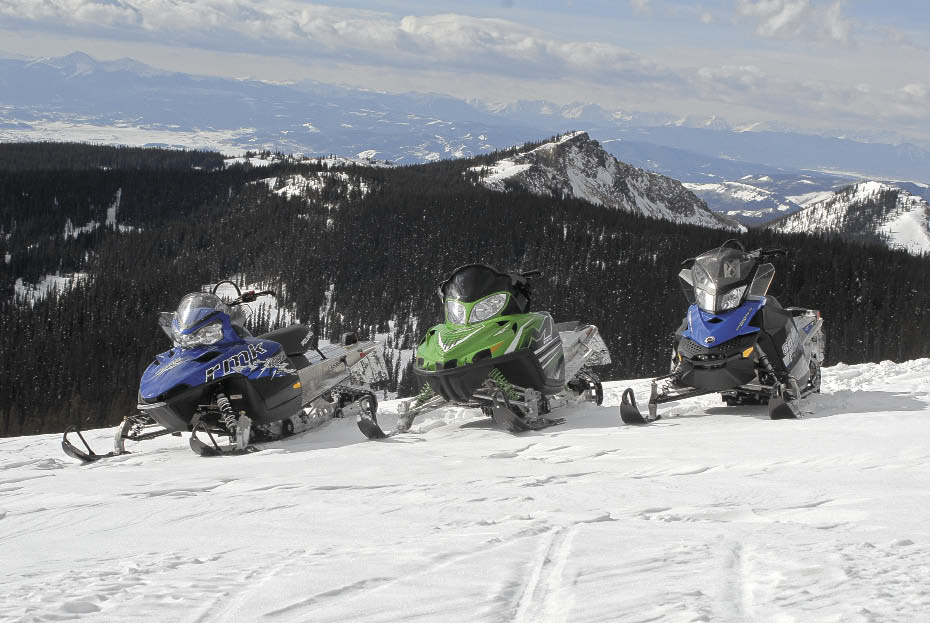 This is where the "beginner" comes into the picture. Even at 120 hp, the 600s are a great stepping stone for young riders or those new to the sport who really should start on a smaller sled before making the leap to a 700, 800 or even bigger machine. The 600 class sleds aren't that much lighter than the bigger displacement sleds (only usually a few pounds) but the difference in horsepower can be the difference between a great learning experience or being intimidated-
This is where the "beginner" comes into the picture. Even at 120 hp, the 600s are a great stepping stone for young riders or those new to the sport who really should start on a smaller sled before making the leap to a 700, 800 or even bigger machine. The 600 class sleds aren't that much lighter than the bigger displacement sleds (only usually a few pounds) but the difference in horsepower can be the difference between a great learning experience or being intimidated-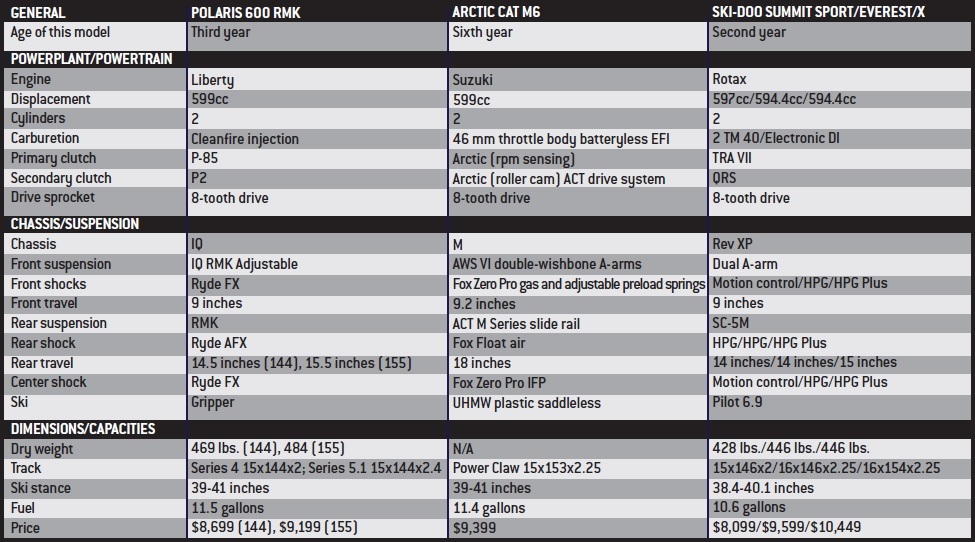 regardless of the age of the rider.
regardless of the age of the rider.
We've been taken to the woodshed in the past because we've labeled the 600s the beginner class and that apparently offended some experienced riders who are perfectly content with their 600cc sleds. We've got no problem with that because we love to ride the 600s, too. However, we still think it's a better idea for those new to the sport to start out on a smaller displacement sled and then move up the ladder. Right now, that bottom rung (again, with two exceptions) is the 600. You gotta start somewhere and the 600s won't disappoint.
Bo Derek
See the Angelina Jolie Stock Index entry. Yes, that dates some of us here at SnoWest Magazine and no, there are no perfect 10s when it comes to snowmobiles-yet. We have had some 10 rides, though, including last April on several 600cc sleds. Those snowmobiles worked the deep powder well that day (we had about two feet of fresh). We may not have been able to climb many mountains because of the deep snow, but it was fun to try and we look at that as a challenge, not a downside of 600cc snowmobiles. Sure these sleds have their limitations but not as many as a fan sled or the old 500s. The 2010 600s are light years ahead of those older machines. That's exactly why some riders never feel the need to move up the bigger displacement sleds.
Core Competencies
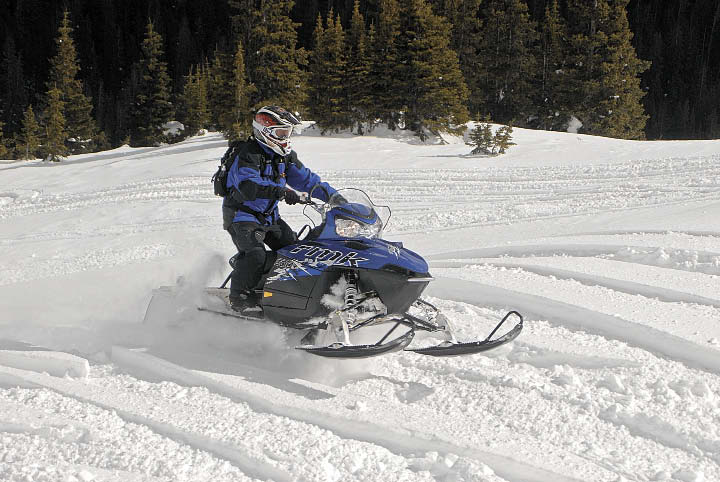 "The main strengths or strategic advantages of a business." Or in our case, the "main strengths of each mountain 600."
"The main strengths or strategic advantages of a business." Or in our case, the "main strengths of each mountain 600."
Before we jump into the specifics of each brand's 600, we think one of the strengths of the class overall is the combination of track and engine size. You could have slapped a longer track on the old 500s but it didn't have the motor to turn it in deeper snows. With the 600s, the 144-154-inch tracks and 120-horsepower engines are a good combination that works well except in the very deepest of snow.
Specifically by brand, the Arctic Cat M6 has three outstanding features: the Power Claw track (see "Tunneling"), new blow-molded seat (see "Seat") and running boards. Cat's running boards are the best-both in their shape and how well the snow is evacuated. The last thing you want detracting from your ride in the snowy depths is an ice skating rink on your running boards. Not gonna happen with Cat's boards.
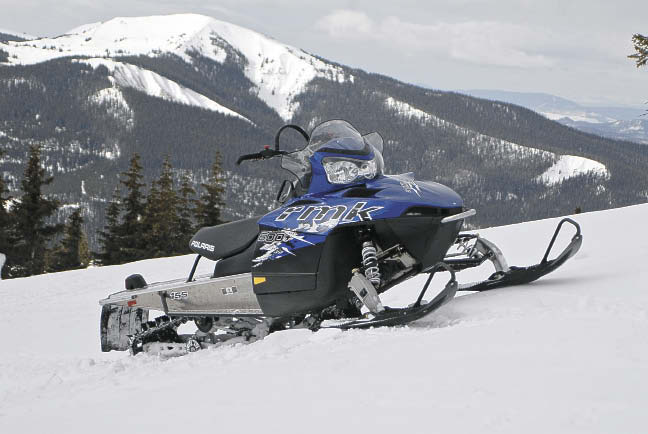 When it comes to the Polaris 600 RMK, the company has trotted out a new clutch, the P2. This secondary clutch is lightweight and offers improved backshift as well as increased overwind for better top end speed. The SnoWest SnowTest crew also likes the bar hooks on the handlebars. The hooks offer just that much more control and ease of steering-on and off trail. We're also big fans of Polaris' Gripper skis. They're plenty good on the trail but they really excel in powder conditions, especially when working your way through the trees.
When it comes to the Polaris 600 RMK, the company has trotted out a new clutch, the P2. This secondary clutch is lightweight and offers improved backshift as well as increased overwind for better top end speed. The SnoWest SnowTest crew also likes the bar hooks on the handlebars. The hooks offer just that much more control and ease of steering-on and off trail. We're also big fans of Polaris' Gripper skis. They're plenty good on the trail but they really excel in powder conditions, especially when working your way through the trees.
For Ski-Doo, the new seat (see "Seat") is a big hit with the SnowTest crew as are the HPG shocks (see "Shock Absorber") and the silky smooth E-Tec engine, which you can only get in the X and Everest models. Ski-Doo uses the Rotax 600 carbureted engine in the Summit Sport.
Lots of ink has been used to describe the 600 E-Tec and the attention that powerplant is getting is well deserved. The E-Tec is very easy to start and has an easy throttle pull, which makes for fun boondocking because the power is so manageable.
Dry Powder
 "A slang term for cash reserves kept on hand to cover future obligations." Yea, that's not our definition. Dry powder is what most every western snowmobiler craves and when you do get that kind of snow, you want a sled that moves you.
"A slang term for cash reserves kept on hand to cover future obligations." Yea, that's not our definition. Dry powder is what most every western snowmobiler craves and when you do get that kind of snow, you want a sled that moves you.
Part of that moving you is the ability to leverage the sled to your advantage, meaning, getting it to move where you want it to go when you want it to go. That's the chassis' function and when it comes to body English, Cat's M chassis is the most responsive to even the slightest move of the rider. You can essentially steer with your knees as well as the handlebars. Polaris is second most responsive and Ski-Doo third. We're talking about responsiveness in deep powder, not necessarily on trails.
Just as is the case with the bigger 800 siblings with all three brands, Cat and Polaris are the easiest to sidehill and lay down in the powder, followed by Ski-Doo, although all Summits have a new handling package and revised steering system that have brought those sleds closer to what the M and RMK can do.
Funemployment
That's what our jobs are. And yes, we have fun on the 600s.
Kicking The Tires
 "Slang for doing the grassroots research of a prospective investment." Doing your homework before spending thousands of dollars on anything, let alone a toy, is a wise thing to do. So, when we're looking at the 600 mountain class, we look at the good and the bad. We've picked one beef we have about each brand's 600 that would cause us to hesitate ever so slightly before buying.
"Slang for doing the grassroots research of a prospective investment." Doing your homework before spending thousands of dollars on anything, let alone a toy, is a wise thing to do. So, when we're looking at the 600 mountain class, we look at the good and the bad. We've picked one beef we have about each brand's 600 that would cause us to hesitate ever so slightly before buying.
On the M6 it's the lack of telescopic steering, which you can get on the M8 Sno Pro, HCR and M1000 but not on the M6. The telescopic steering is what helps define the M Series sleds as mountain machines. The standard steering system is too low, even for shorter riders.
Our beef with the 600 RMK is the running boards. The bottom line here is they don't shed the snow like mountain riders need in deep powder and they don't offer that much traction either. Stay on the trails and it's no big deal, but dive off into the powder and it's a struggle to find your footing.
It might look like we're ganging up on Ski-Doo and the Summit 600 here but we're going to look at two different 6s-the Summit Everest and Summit Sport. As for the Sport, it's not even probably fair for us to single out the shock package because this sled is billed as an economy snowmobile and that means a very basic shock package. We've been spoiled by the HPG shocks and their excellent capabilities in the rough and the Motion Controls really play second fiddle. But then, the Sport is $1,500 cheaper than an Everest so . we told you we were splitting hairs.
The ding on the Everest is the same as what you've heard us claim on the Summit 800s-its maneuverability in deep powder. We're not going to beat a dead horse here so if you want to read about our feelings on this, pick up a September issue of SnoWest.
Lemon
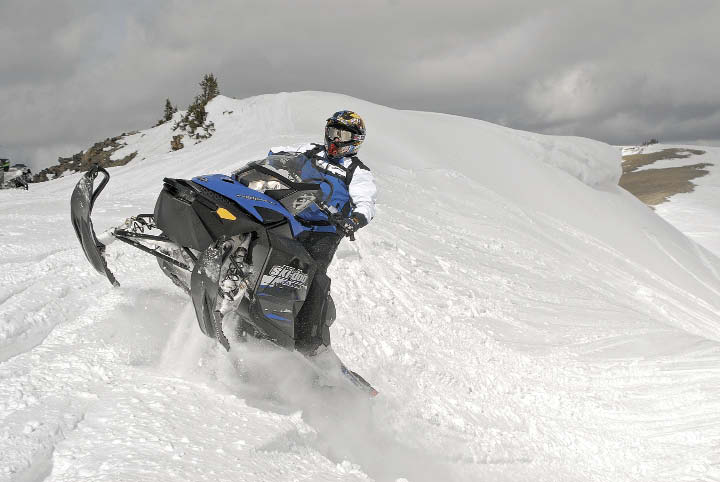 "A very disappointing investment. Your expected return wasn't even close to being achieved." There's not a lemon in the 600 group because, as a segment, this is one of the "oldest" in the mountains in terms of age of vehicles. The average age of the sleds in the 600 class is a little more than three years-with Arctic Cat's M6 being the oldest at six years and Ski-Doo the youngest at two years.
"A very disappointing investment. Your expected return wasn't even close to being achieved." There's not a lemon in the 600 group because, as a segment, this is one of the "oldest" in the mountains in terms of age of vehicles. The average age of the sleds in the 600 class is a little more than three years-with Arctic Cat's M6 being the oldest at six years and Ski-Doo the youngest at two years.
These sleds are proven. The chassis are solid. The engines haven't shown any major glitches. These machines work and work well.
Play
"A slang term that describes the positive aspects of an investment decision." We hear very few-if any-complaints about the sleds in the 600 class. Buy one of these machines and you won't be disappointed in your investment. In fact, one thing we've noticed about the 600 class is that sledders who do buy these machines tend to hang on to them, even if they move up the ladder to a bigger sled. They keep their 600 around for maybe their kids or just as a second sled.
Seat
 How easy is this Investopedia buzz word for the snowmobile community to understand?
How easy is this Investopedia buzz word for the snowmobile community to understand?
This is the one part of nearly all the sleds in the 600 class that is new for 2010.
The M6 seat is all new and is 3.5 lbs. lighter than the '09 model. Kudos to Cat for having a lightweight seat with storage. We love the height and width of the new seat.
Polaris is now using the Switchback seat on the 600 RMK with the 144-inch track. The 6 with the 155 is the standard RMK seat, which was our favorite until Arctic Cat and Ski-Doo made changes for 2010. In fact, it's a toss up now amongst the SnowTest crew as to which is our favorite. All RMK seats also get a new material to cover the seat, making it a little grippier, especially when it's wet or has a bit of snow on it.
Ski-Doo's new seat really soaked up the bumps during our testing this past winter. It's very impressive through the stutter bumps and we really like the height and width of the new seat. The seat is 1.25 inches taller and 1.5 inches narrower.
While the SnowTest crew can't agree on which seat is the best, we do agree that the seats are one of our favorite new features on the 600s for 2010.
Shock Absorber
 Here's another easy crossover from the financial world to the sled world.
Here's another easy crossover from the financial world to the sled world.
Ski-Doo utilizes HPG Plus shocks in the Summit X 600 and we think these are definitely the high end when it comes to a plush ride in the bumps. These are high pressure gas shocks that feature an aluminum body and are rebuildable and revalvable. The Summit Everest uses HPG shocks, which are still a nice high pressure gas shock, but they have a steel body (a little heavier than the aluminum) and are not rebuildable and revalvable. We've already mentioned the budget Motion Control shocks on the Summit Sport, which you'll find on the front suspension and center shock position. Ski-Doo does use the HPG in the back of the rear suspension. And that certainly helps the ride.
On both 600 RMKs Polaris uses RydeFX on the front suspension and in the center shock position and the more premium RydeAFX shock in the rear track spot.
Arctic Cat flies solo with Fox Shocks on all its M Series sleds, including the M6. On the front it's Fox Zero Pro gas shocks as well as in center shock position. Out back it's the Fox Float.
There Ain't No Such Thing As A Free Lunch
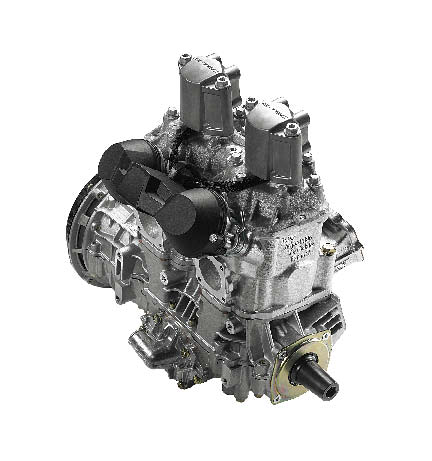 "TANSTAAFL expresses the idea that even if something seems like it is free, there is always a cost, no matter how indirect or hidden." This is especially true when it comes to snowmobiles. You have to pay to play.
"TANSTAAFL expresses the idea that even if something seems like it is free, there is always a cost, no matter how indirect or hidden." This is especially true when it comes to snowmobiles. You have to pay to play.
Without looking at the overall price of each sled, Polaris had the steepest price increase in the 600 class as the 144 and 155 each went up $700. Ski-Doo was next as each 600 model in its stable was bumped up $250. Cat increased the price of the M6 $200.
Ski-Doo has the most expensive sled in the 600 class (Summit X at $10,449) and the least expensive (Summit Sport at $8,099). Cat is the next most expensive at $9,399 followed by Polaris, whose two sleds average $8,949.
Do the sleds justify the cost? That's something only you can decide. But in the case of the M6, for example, which went up $200, the new seat is worth that bump in price alone.
The bottom line here is the consumer has to decide whether or not they consider these the economy class of mountain snowmobiles.
Tunneling
It seems logical to talk about tracks in this section. The Investopedia entry for tunneling was some mumbo jumbo about an illegal practice of directing company assets or future business to yourself.
Track lengths in the 600 class include 144, 146, 153, 154 and 155 inches while lug heights are 2, 2.25 and 2.4 inches. Arctic Cat and Polaris tracks are 15 inches wide while Ski-Doo uses a 16-inch wide track, except on the Summit Sport, which is 15 inches wide.
All the tracks work well in most snow conditions you might encounter but if there's one that has an edge in everything from real nasty to fluffy powder to hardpack, it would be Cat's Power Claw track. It's ready for anything.
Window Dressing
"A strategy used by mutual fund and portfolio managers near the year or quarter end to improve the appearance." In the snowmobile industry we call it Bold New Graphics and essentially that's what the 600 class comes to the 2010 season with. We've highlighted most of the changes, which are mostly minor and cosmetic for this winter. However, that in no way detracts from the 600 lineup. These machines will once again prove their place in the mountains and do it without all the fanfare the bigger 800cc class gets.